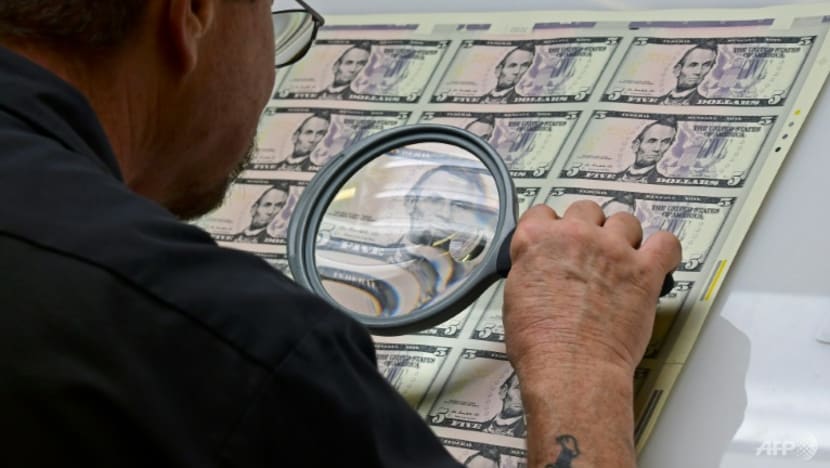Commentary: US Fed should not shy away from raising interest rates more aggressively
The Federal Reserve has been focused on a "soft landing" to slow inflation without sending the US economy into recession. But it can be less cautious about hiking interest rates without worrying so much that unemployment will jump dramatically, argues this professor.

Expectations that the Federal Reserve will lift interest rates several times this year have sent the dollar to multi-year highs against its major peers. (Photo: AFP/Eva HAMBACH)
NEW YORK: Inflation surged at the fastest pace in over 40 years in May, pushing the Federal Reserve towards a more aggressive pace of interest rate increases to slow it down. While there’s concern it could cause unemployment to spike, a little-known economics indicator suggests the Fed can do so without causing too much economic pain.
The Fed has already raised interest rates twice in recent months – including a half-point hike in early May – in an effort to tame inflation.
Yet the consumer price index rose to an annualised rate of 8.6 per cent from 8.3 per cent in April, the Bureau of Labor Statistics reported on Friday (Jun 10). That’s above economic forecasts of 8.2 per cent and the highest reading since December 1981, which is the tail end of the last time the US economy wrestled with ferocious inflation.
In other words, the actions by the central bank so far don’t appear to have had much of an effect.
But lifting rates further could come at a cost. Economists fear that raising rates too fast and too steeply would likely put the brakes on economic growth, resulting in an economic recession and soaring unemployment.
Yet as an economist who studies inflation, I believe there are several reasons the Fed can more fiercely fight inflation without worrying so much about unemployment.
HAS THE FED BEEN MOVING TOO SLOWLY?
Economists and investors have been urging the Fed to get more aggressive for many weeks. Their main argument is that soaring inflation is at least partly the fault of the Fed – and the federal government. US policymakers pursued very aggressive stimulus programs to cushion the economy-pummeling effects of COVID-19.
The roughly US$4.6 trillion in stimulus money eventually led to an increase in overall demand for goods and services, which drove up prices at the same time that supply chains were a mess.
Compounding matters, Russia’s invasion of Ukraine has caused a spike in oil and gas prices.
Meanwhile, the Fed has been accused of being slow to take policy actions that could have helped tame inflation sooner. Even the 0.5 percentage point rate increase in May seems weak in retrospect.
In the Fed’s defence, it has good reason to be cautious. The Fed has what is known as a dual mandate to not only keep inflation in check but to promote maximum employment. The trouble is that actions intended to reduce inflation can cause unemployment to rise.
And so the Fed has been focused on executing a so-called soft landing – in which it raises interest rates enough to slow inflation but not so much it sends the economy into recession – which would likely result in fewer job vacancies and more Americans without work. But I think the Fed now has two big reasons to throw its caution to the wind.
THERE IS ROOM FOR AGGRESSION
The first is what the latest inflation data tells us. Runaway inflation is terrible for an economy, and very painful for consumers, so the Fed has no choice but to bring it down at whatever cost.
The other has to do with what is known as the Beveridge curve, a tool economists use to analyse the labour market and one increasingly being monitored by Fed Chair Jerome Powell and others. The Beveridge curve looks at the statistical relationship between the level of unemployment and the number of open job vacancies.
The idea behind this curve is pretty straightforward: When there are many unfilled vacancies, the labour market is extremely tight, and it is easy to find work, leading to an extremely low level of unemployment. On the other hand, in a slack market, the number of vacancies is low and it is more difficult to find jobs and the unemployment is high.
In May, there were 11.5 million job vacancies in the US for 6 million unemployed people. This nearly 2:1 ratio is wildly high – the highest ever recorded.
In contrast, before the pandemic, when the labour market was in very solid shape, there was one vacancy for every two unemployed people. The Beveridge curve uses rates, so it currently shows a 7.3 per cent job opening rate over a 3.6 per cent unemployment rate.
Historically, a drop in job openings – prompted by a slowing economy, for instance – corresponds with a rise in unemployment and vice versa. But the pandemic has changed the existing pattern dramatically, and it looks as if unemployment is less responsive to changes in the job opening rate.
This means the Fed could get more aggressive about hiking interest rates to curb inflation without worrying so much that a drop in job vacancies due to an economic slowdown will cause unemployment to jump dramatically.
That said, we should also keep in mind that the latest numbers represent a lagging indicator. It takes time for the Fed’s policies to be seen in the data, and for all we know the rate hikes are already having an effect.
Still, I believe the Fed has a strong case for more aggressive action – so don’t be surprised if the US central bank lifts rates by 0.75 percentage points at its next meeting in mid-June. That would be the biggest increase since 1994.
Veronika Dolar is an Assistant Professor of Economics at SUNY Old Westbury. This commentary first appeared in The Conversation.

















